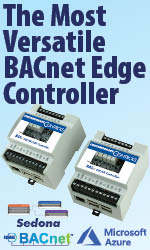May 2012
Article
AutomatedBuildings.com
BTL Mark: Resolve interoperability issues & increase buyer confidence
BACnet Testing Laboratories
(Click
Message to Learn More)
San Francisco Public Utility Commission Sets an Example
o Exterior sun shades for daylighting and glare
management
o Natural ventilation with the use of operable windows
o Reduced lighting power densities with workstation
task lighting
o Wind turbines along the façade
o Three roof top solar platforms
o Daylight harvesting
o Light shelves integrated into the window walls for
daylighting
o Faucet sensors, waterless urinals and on-demand
water heaters
o Living Machine wastewater recycling for flushing
use
o Rain Harvesting for irrigation
In addition to its candidacy for LEED and Smart Building
Certifications, the building architect, KMD, was honored with two
awards from the San Francisco American Institute of Architects (AIA).
The project won for its ‘Integrated Project Delivery’, a best practice
that results in improved coordination and a timely delivery.
System Integration
Adhering to the LEED process and standards put the “green” in the
building, but what makes it smart? The Integrated Building
Management System™ (IBMS) integrates data from every building system
and allows for read or write capability of 13,500 data points.
The integration of systems increases the functionality between the
building systems, and also provides a suite of software applications
and operational tools monitor and manage the building’s performance in
real-time.
“The design team worked together to make this project an innovative
masterpiece of building design. Without the team collaboration,
there would have been missed opportunities,” states Vafaei.
During the design of the IBMS, a “compliance statement” was issued to
all system designers. This statement required the use of open
communication protocols and databases, as well as submittals of points
list, IP addresses, control drawings, and all other pertinent
information on the building’s systems. The compliance statement was
instrumental in configuring and integrating the systems.
IBMS
The IBMS can monitor and manage every data point from every building
system; that in itself sets a new benchmark. The systems monitored and
managed by the IBMS include:
o Waste Water Treatment System
o Mechanical Direct Digital Controls
o Digital Network Lighting Controls
o Power Monitoring and Control System
o Fire Alarm and Detection System
o Solar Energy Collector Metering
o Wind Energy Power Generator Metering
o Interior & Exterior Shade Control System
o Weather Station Monitoring System
o Window Washing System
o Water Reclamation
 The IBMS collects and converts the building systems data into a
standard format. The “standardized” data is utilized by a variety of
software modules to provide information and manage building operations.
The IBMS collects and converts the building systems data into a
standard format. The “standardized” data is utilized by a variety of
software modules to provide information and manage building operations.
“The integration of all the data points of all the building subsystems
is a new model for monitoring and managing a building’s performance –
it has not been done before to this level of detail and sophistication
,” states Andres Szmulewicz of Smart Buildings, LLC, the firm that
served as IBMS Designer for the project.
The IBMS has some typical BMS applications such as document management,
trending, system scheduling and data archiving, but also several
applications not available in traditional building management systems
including:
o Building Performance Analytics – The analytic module utilizes a rule-based fault detection and diagnostic application to optimize the performance of the HVAC systems. It provides ongoing commissioning, keeping the largest energy consumption system at optimal performance. A building can typically expect a 10-25% energy savings in the HVAC systems from the use of these advanced software tools.
o Alarm Management – This module allows for alarm management across all subsystems, identifying priority alarms and correlating alarms to one event.
o Public Information and Education – The IBMS reports savings and efficiencies via a public dashboard. Visitors, tenants and occupants are able to track sustainability initiatives and goals against actual, real-time use. This display helps to promote, educate and encourage conservation.
In addition, the IBMS can integrate into an existing facilities
management system (FMS). The FMS has applications such as work orders,
asset management, inventory, preventative maintenance, etcetera. The
IBMS and the FMS will exchange data with each other. For example, an
alarm in the IBMS will trigger a work order in the FMS; or the FMS may
trigger a preventative or predictive maintenance service order based
equipment run time data obtained from the IBMS.
“There are several benefits to this approach and deployment. One is
that with a central Meta database, it is easier to create relevant
information that will support improved building operations and
engineering. It also allows us to integrate the systems functionally,
where an event or condition in one system can trigger action in another
system. We become more proactive and less wait, break and fix and
thereby improving the quality and lifecycle of our equipment,” states
Vafaei.
Dashboards
The data in the IBMS is transformed onto dashboards. Dashboards provide
information specific to a user group. For example, a dashboard may
provide facility operators with high level information on alerts and
alarms for a particular system, area, and time period. Or, a dashboard
may allow individual departments to track their energy consumption and
sustainability initiatives.
There are over 450 dashboards being developed to provide facility
engineers, operators, facility managers, business managers and
executives, employees, visitors and the public with information
specific to their needs. Users of this information are armed with the
tools necessary to contribute to building optimization, performance and
efficiency.
The SFPUC has constructed a top notch energy efficient and sustainable
building. The IBMS assures that advanced software tools will provide
the SFPUC long term capabilities to manage building operations, energy,
sustainability and ongoing costs.
About the Author:
Jim Sinopoli is Managing Principal of Smart Buildings, LLC, an
engineering and consulting company. Smart Buildings served as the
Master Systems Designer, working with the project team to design and
develop the IBMS.
[Home Page] [The Automator] [About] [ Subscribe ] [Contact Us]



